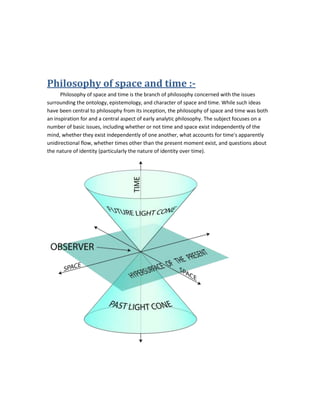
Philosophy of space and time
- 1. Philosophy of space and time :- Philosophy of space and time is the branch of philosophy concerned with the issues surrounding the ontology, epistemology, and character of space and time. While such ideas have been central to philosophy from its inception, the philosophy of space and time was both an inspiration for and a central aspect of early analytic philosophy. The subject focuses on a number of basic issues, including whether or not time and space exist independently of the mind, whether they exist independently of one another, what accounts for time's apparently unidirectional flow, whether times other than the present moment exist, and questions about the nature of identity (particularly the nature of identity over time).
- 2. Gravitation and the General Theory of Relativit y The theoretical physicist Albert Einstein introduced his Special Theory of Relativity in 1905 and hisGeneral Theory of Relativity in 1915. The first showed that Newton's Three Laws of Motion were only approximately correct, breaking down when velocities approached that of light. The second showed that Newton's Law of Gravitation was also only approximately correct, breaking down when gravitation becames very strong. Special Relativity:- Einstein's Special Theory of Relativity is valid for systems that are not accelerating. Since from Newton's second law an acceleration implies a force, special relativity is valid only when no forces act. Thus, it cannot be used generally when there is a gravitational field present (as we shall see below in conjunction with the Principle of Equivalence, it can be used over a sufficiently localized region of spacetime). We have already discussed some of the important implications of the Special Theory of Relativity. For example, the most famous is probably therelationship between mass and energy. Other striking consequences are associated with the dependence of space and time on velocity: at speeds near that of light, space itself becomes contracted in the direction of motion and the passage of time slows. Although these seem bizarre ideas (because our everyday experience typically does not include speeds near that of light), many experiments indicate that the Special Theory of Relativity is correct and our "common sense" (and Newton's laws) are incorrect near the speed of light.
- 3. General Relativity:- The General Theory of Relativity was Einstein’s stupendous effort to remove the restriction on Special Relativity that no accelerations (and therefore no forces) be present, so that he could apply his ideas to the gravitational force. It is a measure of the difficulty of the problem that it took even the great Einstein approximately 10 years to fully understand how to do this. Thus, the General Theory of Relativity is a new theory of gravitation proposed in place of Newtonian gravitation. Tests of the Theory of General Relativity:- General Relativity and Newton's gravitational theory make essentially identical predictions as long as the strength of the gravitational field is weak, which is our usual experience. However, there are several crucial predictions where the two theories diverge, and thus can be tested with careful experiments. The orientation of Mercury's orbit is found to precess in space over time, as indicated in the adjacent figure (the magnitude of the effect is greatly exaggerated for purposes of illustration). This is commonly called the "precession of the perihelion", because it causes the position of the perihelion to move around the center of mass. Only part of this can be accounted for by perturbations in Newton's theory. There is an extra 43 seconds of arc per century in this precession that is predicted by the Theory of General Relativity and observed to occur (recall that a second of arc is 1/3600 of an angular degree). This effect is extremely small, but the measurements are very precise and can detect such small effects very well. Einstein's theory predicts that the direction of light propagation should be changed in a gravitational field. Precise observations indicate that Einstein is right, both about the effect and its magnitude. We have already seen a spectacular consequence of the deflection of light in a gravitational field: gravitational lensing.
- 4. The General Theory of Relativity predicts that light coming from a strong gravitational field should have its wavelength shifted to larger values (a redshift). Once again, detailed observations indicate such a redshift, and that its magnitude is correctly given by Einstein's theory. The electromagnetic field can have waves in it that carry energy and that we call light. Likewise, the gravitational field can have waves that carry energy and are called gravitational waves. These may be thought of as ripples in the curvature of spacetime that travel at the speed of light. Just as accelerating charges can emit electromagnetic waves, accelerating masses can emit gravitational waves. However gravitational waves are difficult to detect because they are very weak and no conclusive evidence has yet been reported for their direct observation. They have been observed indirectly in the binary pulsar. Because the arrival time of pulses from the pulsar can be measured very precisely, it can be determined that the period of the binary system is gradually decreasing. It is found that the rate of period change (about 75 millionths of a second each year) is what would be expected for energy being lost to gravitational radiation, as predicted by the Theory of General Relativity. The Modern Theory of Gravitation:- Our best current theory of gravitation is the General Theory of Relativity. However, only if velocities are comparable to that of light, or gravitational fields are much larger than those encountered on the Earth, do the Relativity theory and Newton's theories differ in their predictions. Under most conditions Newton's three laws and his theory of gravitation are adequate.
